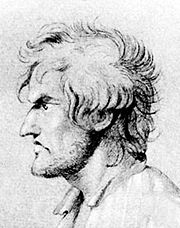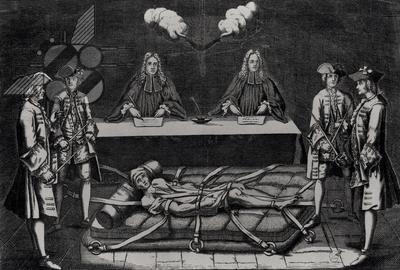
Robert-François Damiens
Encyclopedia

French people
The French are a nation that share a common French culture and speak the French language as a mother tongue. Historically, the French population are descended from peoples of Celtic, Latin and Germanic origin, and are today a mixture of several ethnic groups...
domestic servant whose attempted assassination of King Louis XV
Louis XV of France
Louis XV was a Bourbon monarch who ruled as King of France and of Navarre from 1 September 1715 until his death. He succeeded his great-grandfather at the age of five, his first cousin Philippe II, Duke of Orléans, served as Regent of the kingdom until Louis's majority in 1723...
of France
France
The French Republic , The French Republic , The French Republic , (commonly known as France , is a unitary semi-presidential republic in Western Europe with several overseas territories and islands located on other continents and in the Indian, Pacific, and Atlantic oceans. Metropolitan France...
in 1757 culminated in his notorious and controversial public execution
Public Execution
Public Execution is a Mouse and the Traps retrospective album that has been released in both LP and CD formats. The LP has an unusually large number of tracks , while the CD includes 4 bonus tracks and catalogues almost all of the released music by Mouse and the Traps and their associated bands: ...
. He was the last person to be executed in France by drawing and quartering, the traditional and gruesome form of death penalty used for regicide
Regicide
The broad definition of regicide is the deliberate killing of a monarch, or the person responsible for the killing of a monarch. In a narrower sense, in the British tradition, it refers to the judicial execution of a king after a trial...
s.
Early life
Damiens was born on 9 January 1715 in La ThieuloyeLa Thieuloye
La Thieuloye is a commune in the Pas-de-Calais department in the Nord-Pas-de-Calais region of France.-Geography:Le Thieuloye is situated northwest of Arras, near the junction of the D77 and the N41 road.-Population:-Places of interest:...
, a village near Arras
Arras
Arras is the capital of the Pas-de-Calais department in northern France. The historic centre of the Artois region, its local speech is characterized as a Picard dialect...
in northern France. He enlisted in the army at an early age. After his discharge, he became a domestic servant at the college of the Jesuits in Paris
Paris
Paris is the capital and largest city in France, situated on the river Seine, in northern France, at the heart of the Île-de-France region...
, and was dismissed from this as well as from other employments for misconduct, earning him the epithet of Robert le Diable (Robert the Devil).
Damiens' motivation has always been questionable: historians often describe him as mentally unstable. From his answers under interrogation, Damiens seems to have been excited by the schism
Schism
- Religion :* Schism , a division or a split, usually between people belonging to an organization or movement, most frequently applied to a break of communion between two sections of Christianity that were previously a single body...
atic uproar which followed the refusal of the French Catholic clergy to grant holy sacraments
Sacraments of the Catholic Church
The Sacraments of the Catholic Church are, the Roman Catholic Church teaches, "efficacious signs of grace, instituted by Christ and entrusted to the Church, by which divine life is dispensed to us. The visible rites by which the sacraments are celebrated signify and make present the graces proper...
to the Jansenists, a sect which was considered heretical. He appears to have planned a punishment for the king, upon whom he placed ultimate blame.
Assassination attempt
On January 5, 1757, as the king was entering his carriage, Damiens rushed forward and stabbed him with a knife, inflicting only a slight wound. He made no attempt to escape, and was apprehended at once. He was then tortureTorture
Torture is the act of inflicting severe pain as a means of punishment, revenge, forcing information or a confession, or simply as an act of cruelty. Throughout history, torture has often been used as a method of political re-education, interrogation, punishment, and coercion...
d to force him to divulge the identity of his accomplices or those who had sent him. This was unsuccessful. He was condemned as a regicide by the Parlement
Parlement
Parlements were regional legislative bodies in Ancien Régime France.The political institutions of the Parlement in Ancien Régime France developed out of the previous council of the king, the Conseil du roi or curia regis, and consequently had ancient and customary rights of consultation and...
of Paris, and sentenced to be drawn and quartered by horses at the Place de Grève
Place de Grève
The public square in the 4th arrondissement of Paris that is now the Place de l'Hôtel de Ville was, before 1802, called the Place de Grève. The French word grève refers to a flat area covered with gravel or sand situated on the shores or banks of a body of water...
.
Torture and execution

Charles Henri Sanson
Charles Henri Sanson, full title Chevalier Charles-Henri Sanson de Longval was the Royal Executioner of France in the court of King Louis XVI and High Executioner of the First French Republic...
. Horses were harnessed to his arms and legs, but Damiens' limbs did not separate easily: after several more hours, the officients were forced to have Sanson cut Damiens' joints with an axe. Damiens was dismembered to the applause of the crowd, and his torso - reportedly still living - was burnt at the stake.
Aftermath
After his death, the remains of Damiens' corpse were reduced to ashes and scattered in the wind. His house was razed to the ground, his brothers and sisters were ordered to change their names, and his father, wife, and daughter were banished from France.Because France had not experienced a regicide for a century and a half, Damiens' infamy endured. Forty years after his death, Arras' most notorious citizen was used against another Arras native, Maximilien Robespierre
Maximilien Robespierre
Maximilien François Marie Isidore de Robespierre is one of the best-known and most influential figures of the French Revolution. He largely dominated the Committee of Public Safety and was instrumental in the period of the Revolution commonly known as the Reign of Terror, which ended with his...
. The polarizing dictator of the French Revolution
French Revolution
The French Revolution , sometimes distinguished as the 'Great French Revolution' , was a period of radical social and political upheaval in France and Europe. The absolute monarchy that had ruled France for centuries collapsed in three years...
was described frequently by his enemies as the nephew of Damiens. Though completely untrue, the libel held considerable credibility among royalist
Royalist
A royalist supports a particular monarch as head of state for a particular kingdom, or of a particular dynastic claim. In the abstract, this position is royalism. It is distinct from monarchism, which advocates a monarchical system of government, but not necessarily a particular monarch...
s and foreign sympathizers.
Legacy
The execution was witnessed by famous 18th-century adventurer Giacomo CasanovaGiacomo Casanova
Giacomo Girolamo Casanova de Seingalt was an Italian adventurer and author from the Republic of Venice. His autobiography, Histoire de ma vie , is regarded as one of the most authentic sources of the customs and norms of European social life during the 18th century...
, who included a scandalized account in his memoirs.:
The philosopher Cesare Beccaria explicitly cited Damiens' fate when he condemned torture and the death penalty in his classic treatise On Crimes and Punishments (1764). Damiens's execution is also described and discussed at length in the introduction to Michel Foucault
Michel Foucault
Michel Foucault , born Paul-Michel Foucault , was a French philosopher, social theorist and historian of ideas...
's study of systems of punishment, Discipline and Punish
Discipline and Punish
Discipline and Punish: The Birth of the Prison is a book by philosopher Michel Foucault. Originally published in 1975 in France under the title Surveiller et punir: Naissance de la Prison, it was translated into English in 1977. It is an interrogation of the social and theoretical mechanisms behind...
.
Thomas Paine
Thomas Paine
Thomas "Tom" Paine was an English author, pamphleteer, radical, inventor, intellectual, revolutionary, and one of the Founding Fathers of the United States...
in Rights of Man
Rights of Man
Rights of Man , a book by Thomas Paine, posits that popular political revolution is permissible when a government does not safeguard its people, their natural rights, and their national interests. Using these points as a base it defends the French Revolution against Edmund Burke's attack in...
mentions Damiens' execution as an example of the cruelty of despotic governments; Paine argues that these methods were the reason why the masses dealt with their prisoners in such a cruel manner when the French Revolution occurred. An allusion to Damiens' attack and execution, and Casanova's account of it, are used by Mark Twain to suggest the cruelty and injustice of aristocratic power in chapter XVIII of A Connecticut Yankee in King Arthur's Court
A Connecticut Yankee in King Arthur's Court
A Connecticut Yankee in King Arthur's Court is an 1889 novel by American humorist and writer Mark Twain. The book was originally titled A Yankee in King Arthur's Court...
.
Science fiction writer James Morrow
James Morrow
James Morrow is a fiction author. A self-described "scientific humanist", his work satirises organized religion and elements of humanism and atheism....
draws on the incident for the trial of God
Lawsuits against God
Lawsuits against God have occurred in real life and in fiction. Issues debated in the actions include the problem of evil and harmful "acts of God".- Ernie Chambers :In the U.S...
in his novel Blameless in Abaddon. There is also a description of the death of Damiens in Peter Weiss
Peter Weiss
Peter Ulrich Weiss was a German writer, painter, and artist of adopted Swedish nationality. He is particularly known for his plays Marat/Sade and The Investigation and his novel The Aesthetics of Resistance....
' play Marat/Sade
Marat/Sade
The Persecution and Assassination of Jean-Paul Marat as Performed by the Inmates of the Asylum of Charenton Under the Direction of the Marquis de Sade , almost invariably shortened to Marat/Sade, is a 1963 play by Peter Weiss...
. The incident figures prominently in Hanns Heinz Ewers
Hanns Heinz Ewers
Hanns Heinz Ewers was a German actor, poet, philosopher, and writer of short stories and novels. While he wrote on a wide range of subjects, he is now known mainly for his works of horror, particularly his trilogy of novels about the adventures of Frank Braun, a character modeled on himself...
' frame-tale "The Execution of Damiens".

